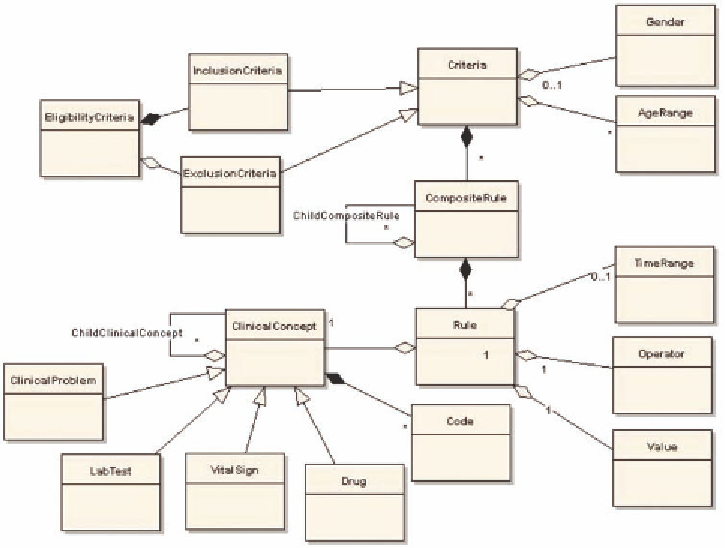Information Technology Reference
In-Depth Information
Figure 2. EQAM: An example of a generic eligibility criteria model
which domain models can be generated. The
focus for our domain was on the needs of the
primary care as a health domain, but the expressed
medical concepts can be expanded or generalized
to other domains. It describes the data in a standard
classification, based on HL7 or CCR, specifying
each main concept, its attributes and relationships.
The domain ontology concepts are mapped to the
local health system service data using a mapping
ontology, which is a configurable XML represen-
tation that can be edited by the users as systems
evolve. It also includes the used terminology for
each class, their versions and the way they are
used in coding their values. For example, the
domain ontology describes Problems, Medica-
tions, Tests, Procedures etc. and their attributes
and relationships. The mapping ontology describes
the corresponding concepts or attributes in the
local health system. The attributes that correspond
to each class may come from different locations,
or tables in the local health system. Each class
may be described by a different terminology,
medical vocabulary or coding system, such as
SNOMED-CT, Read Codes etc. This ontology is
used by the ePCRN-IIB (Interoperable Integration
Broker) services, in this case the Query Generator
Service (QGS), to translate the EQAM into one
or several queries that correspond to the respective
local health system to query or retrieve the respec-
tive data. The Query Enactor Service (QES) is
responsible for enacting and assembling the out-
put.
The
Data Governance ontology
describes the
rules that the service should enforce to control ac-
cess to the data in the health systems. This enables
a flexible mechanism that allows individual health
institutions to specify their data governance policy
and the way their data can be accessed. Each
service includes a configurable data governance
policy that can be changed or updated by the data
owner. These rules are defined as policy rules in
terms of roles and their access privileges. They

Search WWH ::

Custom Search